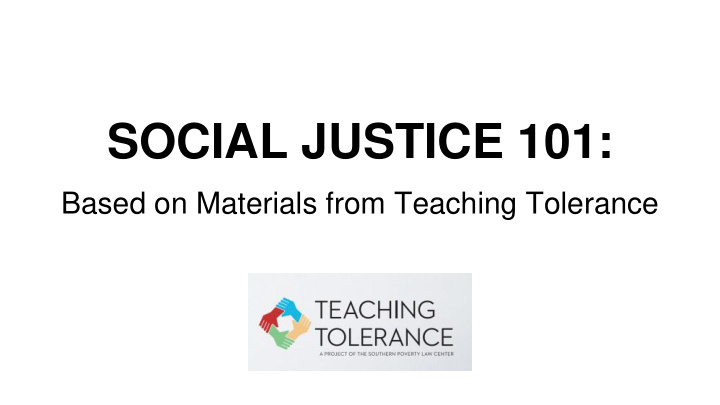



SOCIAL JUSTICE 101: Based on Materials from Teaching Tolerance
About Teaching Tolerance ● Founded in 1991, Teaching Tolerance is dedicated to reducing prejudice, improving intergroup relations and supporting equitable school experiences for our nation’s children. ● The program provides free educational materials, including a K-12 anti-bias curriculum: Perspectives for a Diverse America . Teaching Tolerance magazine is sent to over 400,000 educators, reaching nearly every school in the country. Source: Tolerance.org
Teaching Tolerance Teacher Resources ● Lessons ● Learning Plans ● Student Texts ● Student Tasks ● Teaching Strategies ● Lesson Plan Builder ● Film Kits ● Printable Posters
Teaching Tolerance Professional Development Resources
Teaching Tolerance Community Agreements • Use & receive “I” statements with respect • Respect confidentiality • Embrace messiness & kindness • Practice accountability (intent vs. impact) • Be aware of equity of voice
Friendly Reminder What you learn here leaves here... "Woman blowing on dandelion" by Artem Beliaikin is licensed under CC BY 2.0
OSPI Equity Statement Each student, family, and community possesses strengths and cultural knowledge that benefits their peers, educators, and schools. Ensuring educational equity: ● Goes beyond equality; it requires education leaders to examine the ways current policies and practices result in disparate outcomes for our students of color, students living in poverty, students receiving special education and English Learner services, students who identify as LGBTQ+, and highly mobile student populations. ● Requires education leaders to develop an understanding of historical contexts; engage students, families, and community representatives as partners in decision-making; and actively dismantle systemic barriers, replacing them with policies and practices that ensure all students have access to the instruction and support they need to succeed in our schools.
What is Social Justice?
Social Justice Definitions The National Association of Social Workers defines social justice as: “The view that everyone deserves equal economic, political and social rights and opportunities.” To study social justice is to learn about the problems that dramatically impact quality of life for certain populations, and how people have worked to solve those problems.
Zaretta Hammond • Focuses on exposing the social political context that education or student experience is situated in • Centers around raising students’ consciousness about inequity within the everyday social, environmental, economic, and political aspects of life • Concerns itself with creating lenses to recognize and interrupt inequitable patterns in society
Teaching Tolerance: Social Justice Education Link to Critical Practices for Anti- Link to Social Justice Standards Bias Education
Social Justice Standards • Instruction: Uses culturally responsive instructional strategies that support diverse learners and allow for deep exploration of social justice issues • Classroom Culture: Creates classroom environments that reflect diversity, equity and justice and encourage students to speak out against bias and injustice • Family and Community Engagement: Engages families and communities in ways that are meaningful and culturally competent • Teacher Leadership: Teaches social justice curricula as part of larger individual, school and community action
Anti-Bias Domains • Identity: Each child will demonstrate self-awareness, confidence, family pride and positive social identities. • Diversity: Each child will express comfort and joy with human diversity; accurate language for human differences; and deep, caring, human connections. • Justice: Each child will increasingly recognize unfairness, have language to describe unfairness and understand that unfairness hurts. • Action: Each child will demonstrate empowerment and the skills to act, with others or alone, against prejudice and discriminatory actions.
Guiding Question How can schools affirm identity, celebrate diversity, teach justice and inspire action among students?
2016 Teaching Tolerance Teacher of the Year: Cody Miller Link to Teaching Tolerance Video
Anchor Standards Sort Sort the 20 Anchor Standards into their respective domains: ● Identity ● Diversity ● Justice ● Action Check your sorting when complete. Were there standards you were unsure about? Debrief: Choose a standard. How are you living out this standard in your personal or professional life, and why is it important to do so?
Teaching Tolerance: 20 Social Justice Standards • The standards are not meant to be linear but should function instead as a series of cogs or gears that interlink. Think about keeping this in mind and how it affects your thoughts about how the anchor standards are grouped. • The anchor standards are written in a way that includes some difficult vocabulary and complex concepts. To make the standards more accessible, Teaching Tolerance wrote developmentally appropriate student learning outcomes.
Application
Key Word(s) Protocol Purpose: a time-efficient strategy for organizing the learning of individuals and the group. Each member of the group has a voice. Steps: ● Each table reflects on their learning and selects 1-2 key words that captures and important idea or concept. The word might reflect content or emotion. ● Each member shares their word(s) and why they selected it. ● One member records the words shared at the table. ● Another member shares the table’s words with the whole group.
Recommend
More recommend